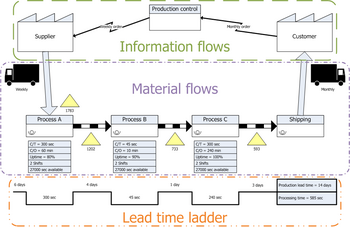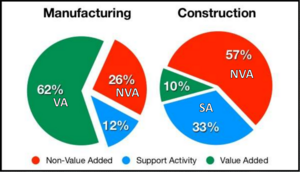Value stream mapping in construction management
| Line 74: | Line 74: | ||
Regarding the application of VSM in the construction industry, no unique guidelines has yet been made on how to implement it. Unlike the manufacturing industry, all construction projects has unique design specifications, and there is very little repetition involved and too much variability <ref name="master_thesis">http://oaktrust.library.tamu.edu/bitstream/handle/1969.1/156276/LI-THESIS-2015.pdf?sequence=1&isAllowed=y</ref>. | Regarding the application of VSM in the construction industry, no unique guidelines has yet been made on how to implement it. Unlike the manufacturing industry, all construction projects has unique design specifications, and there is very little repetition involved and too much variability <ref name="master_thesis">http://oaktrust.library.tamu.edu/bitstream/handle/1969.1/156276/LI-THESIS-2015.pdf?sequence=1&isAllowed=y</ref>. | ||
| − | A paper by (Nimesha Vilasini & J. R. Gamage, 2015)<ref name="conference_paper">https://www.researchgate.net/publication/282156168_Implementing_Value_Stream_Mapping_Tool_in_the_Construction_Industry</ref>, presents a case study of the application of VSM at a precast concrete yard. The aim was to resolve quality issues and reduce the cycle time. Initially process information were gathered, and reflecting the current operation status, a current value stream map were created. | + | A paper by (Nimesha Vilasini & J. R. Gamage, 2015)<ref name="conference_paper">https://www.researchgate.net/publication/282156168_Implementing_Value_Stream_Mapping_Tool_in_the_Construction_Industry</ref>, presents a case study of the application of VSM at a precast concrete yard. The aim was to resolve quality issues and reduce the cycle time. Initially process information were gathered, and reflecting the current operation status, a current value stream map were created. The waste generating activities were identified, and by use of different analysis tools (<span class="plainlinks">[https://en.wikipedia.org/wiki/5_Whys Five whys]</span> <span class="plainlinks">[https://en.wikipedia.org/wiki/Ishikawa_diagram Cause and effect diagram]</span>) the root to the issues were found and solved by a <span class="plainlinks">https://en.wikipedia.org/wiki/Kaizen Kaizen</span>approach. |
Revision as of 21:07, 12 June 2017
Value stream mapping (VSM) is a tool used within the field of Project Management to visualize and improve the overall flow process of a product or service from raw material all the way to the customer. It has its origin at TOYOTA, being a part of their lean management tools, where it is known as “material and information flow mapping”. VSM helps document all the activities required to complete a request from a customer. It includes people who normally manage individual functions or processes, and makes the overall flow of material and information across the entire process visible. In addition, it brings alignment to the organization, by involving the people who in fact do the work, and provides a platform for improvement and implementation. VSM is dynamic tool, since its continuously updated as the processes is being improved. VSM differs from the traditional tool; process/flow maps, by having a process focus, rather than a product focus. It provides a holistic view of how thing work, with a costumer perspective. One vital gain from applying VSM, is that it provides a common language when talking about processes, and allowing people to operate solely based on facts.
Contents |
The Big Idea
VSM generic formulation

Value stream mapping (VSM) originated in the manufacturing industry. It was developed by Toyota Motors Corporation, being a part of their Lean management tools. The Lean management philosophy is to identify and eliminate every activity in the design, production and supply chain management related processes that does not create value for a costumers point of view[2]. Generally it is characterized as a process-improving management philosophy, that seeks to minimize the waste without decreasing the productivity.
Value stream mapping (VSM) is used to both analyse and design the flow of material and information, that is required to bring a product or service to the end customer. It is a visual tool that provides a holistic view of the overall process, and thus a platform for strategically improvement and adding value to the costumers[3]. The goal is to design an “ideal state”, also known as the “future state” by analyzing the “current state”. The current state presents how the process is at the time of making the VSM. This is very important due to the dynamic nature of VSM. The waste present within the work flow system, is identified by reflecting the current state.
The general mapping of a current state is presented in Figure 1, showing the three key points:
- Information flow
- Material flow
- Lead time ladder
Having identified the wastes, a future state can be designed where the wastes are eliminated. Standardized symbols are used when mapping a process state, to obtain a common language for communicating though the VSM[4]. VSM generates security within the organisations, which is essential to success. Insecurity often result in withhold of important information about the flow and processes, and will consequent lead to delay and loss of value.
VSM in the construction industry

The construction industry in terms of productivity, quality and efficiency, is often characterized as a backward industry, that fails to innovate compared to other industries. The Lean Thinking philosophy was adopted to the construction industry since the 1970's, and several successful implementations has been achieved. The Construction Industry Institute states that only 10% are value added inputs and striking 57% are waste. This is compared to the manufacturing industry where 62% is value added and 26% is waste. The lack of performance in the construction industry compared to other industries, has been directly related to the low rate of innovation[3]. These statistics are a major motivation, for studying and identifying the wastage, which is frequently present in the industry. Consequently how to apply Lean tools and techniques to reduce the wastage. Examples of value adding activities are pouring concrete, erecting steel pr installing the roof. Examples of waste are excessive material handling, design errors, conflict between contractors, ineffective supply chain and rework.
8 types of waste in the construction industry

The following table list the 8 types of waste, typically found within the construction industry[5].
| Waste type | Definition/cause | Example |
|---|---|---|
| Inventory | Excess products and material not being processed. | Steel door frames delivered in bundles during steel erection. (Early delivering - just to be safe) |
| Motion | Unnecessary movements by people (e.g. walking). | Early delivery of the steel door frames got in the way of production operation and had to be moved. |
| Defects | Efforts caused by rework, scrap, and incorrect information. | In the process of moving the early delivered steel frame doors, some were damaged. |
| Extra-Processing | More work or higher quality than is required by the costumer. | Some of the damaged doors were repaired, and spending time ordering new doors. |
| Non-Utilized Talent | Under-utilizing peoples talents, skills and knowledge. | Carpenters moved the steel frames to the construction install area. |
| Transportation | Unnecessary movements of products and materials. | New doors has to be delivered on site. |
| Waiting | Wasted time waiting for the next step in a process. | Waiting for the new doors to be delivered. |
| Overproduction | Production that is more than needed or before it is needed. | Due to lack of doors to install, the carpenter began on other tasks too early. |
Application
Regarding the application of VSM in the construction industry, no unique guidelines has yet been made on how to implement it. Unlike the manufacturing industry, all construction projects has unique design specifications, and there is very little repetition involved and too much variability [3].
A paper by (Nimesha Vilasini & J. R. Gamage, 2015)[2], presents a case study of the application of VSM at a precast concrete yard. The aim was to resolve quality issues and reduce the cycle time. Initially process information were gathered, and reflecting the current operation status, a current value stream map were created. The waste generating activities were identified, and by use of different analysis tools (Five whys Cause and effect diagram) the root to the issues were found and solved by a https://en.wikipedia.org/wiki/Kaizen Kaizenapproach.
Limitations
Value stream mapping as a generic Lean tool, cannot be directly applied in the construction industry. It has a huge potential, but modifications and redesign are required for the tool to be generic applicable in the industry. Relevant customization to the tool must be carried out to shown a significant effect[2][3] .
Annotated Bibliography
- ↑ https://en.wikipedia.org/wiki/Value_stream_mapping
- ↑ 2.0 2.1 2.2 https://www.researchgate.net/publication/282156168_Implementing_Value_Stream_Mapping_Tool_in_the_Construction_Industry
- ↑ 3.0 3.1 3.2 3.3 http://oaktrust.library.tamu.edu/bitstream/handle/1969.1/156276/LI-THESIS-2015.pdf?sequence=1&isAllowed=y
- ↑ http://www.strategosinc.com/vsm_symbols.htm
- ↑ 5.0 5.1 5.2 http://c.ymcdn.com/sites/www.nasfa.net/resource/resmgr/Learning_Series/Intro_to_Lean_Construction_&.pdf